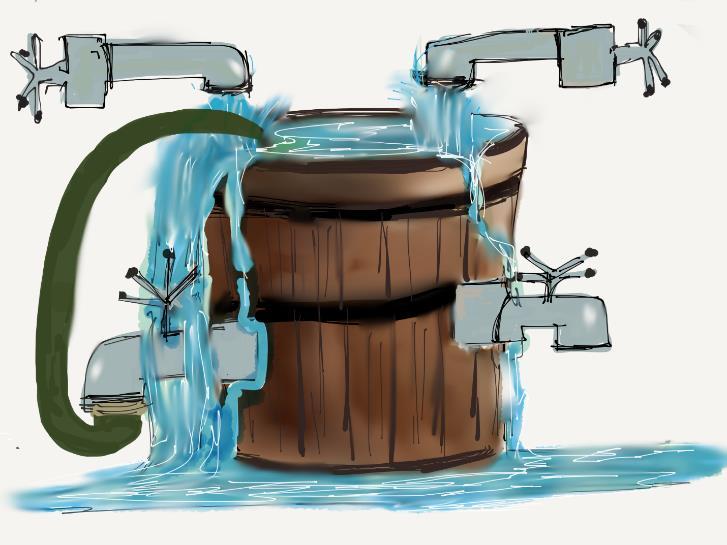
8 minute read
Part 2: Stress Vulnerability Resilience Model
Section 3: Teaching and Learning Together
Part 2: Stress-Vulnerability-Resilience Model
Advertisement
Objectives:
1. 2. To describe the stress-vulnerability-resilience model To discuss ways to use this model and graphic to helps persons better understand their experience and ways to cope
The Stress-Vulnerability-Resilience Model
One of the most important things that you will do is to help a person to
understand or “make sense” of what they are experiencing. In this part of teaching and learning together, we explore what leads a person to experience
symptoms of schizophrenia. The mostcommon way to think about the onset of schizophrenia is that it is caused by a combination of “vulnerabilities” (chiefly related to biological factors like genetics), certain stressful events experienced
early in life (e.g., traumas) that also predispose a person to experience
psychosis, and then exposure to stressful events in late teens and early
adulthood that are thought to precipitate a psychotic episode. This model was
originally referred to as the stress-vulnerability model. The concept of resilience
was added to this model to better represent the strengths that individuals bring
to coping. This model can be applied to most any illness, condition, or stress
reaction, thereby offering some normalizing qualities by its broad applicability -
it is not just a model for mental illness but something we can all use. To go one
step further, this model helps an individual to develop a workable model for
schizophrenia and related experiences. That is, it is offers a common sense
understanding and a way to improve coping to improve quality of life.
Vulnerability
Some individuals are born with, or acquire very early in life, a tendency
to develop problems in certain areas. While our understanding about the
biology of schizophrenia is limited, we do know that the chances of an individual
experiencing schizophrenia are greater ifhe or she has a close relative has been
diagnosed with schizophrenia. So, we suspect that genes are involved in
developing schizophrenia. However, it is also important to remember that some
individuals who have no family history of a psychotic disorder also develop
schizophrenia (so genes are important, but certainly not the whole story).
Several additional factors are thought to affect underlying vulnerability or
predispose a person to experience psychosis. For example, brain injuries and
early exposure to viruses also increase vulnerability to psychosis. In addition, early events that are highly stressful and/or traumatic (such as physical or
sexual abuse, bullying) mayalso influencea person’s vulnerability or
predisposition to experience psychotic symptoms later in life. Also, recent
research suggests that frequent and excessive use of cannabis in early
adolescence will also likely increase a person’s vulnerability to developing schizophrenia
Stress
Stresscan triggertheonsetofpsychoticsymptomsand/ormakethem
worse. Individualsexperience stressverydifferently. Whatisstressful to one
person may not be stressful to another person. There is no way to completely
avoid stress and live a stress-free life. Therefore, it is beneficial to try to
understand what is stressful to the person you are working with. For example,
Having too little to do
Having too much to do
Having arguments and receiving criticism
Experiencing major life changes
Experiencing financial or legalproblems
Feeling sick orphysically unwell
Abusing any alcohol or drug (particularly marijuana) Experiencing a traumatic event (victim of crime, abuse, etc.). Living in poverty or having poor living conditions Experiencing racism or discrimination
Resilience or Protective Factors: One’s ability to recognize strengths and use them to bounce back from adversity is called “resilience.” In addition to personal
strengths, resilience is also about having access to supports (friends, family, and
community) who help you to work toward health and wellness. Often,
individuals who have experienced psychotic symptoms for a long time have lost
sight of their strengths and may fear they cannot count on their supports. It is
important to review strengths and social resources as part of developing a
recovery plan.
Visual Aid
A good way to communicate the stress vulnerability model to clients is to
use a visual aid and metaphor of “The Stress Bucket” developed by Allison
Brabban. Encourage the person you are working with to think about a bucket as
representing capacity to hold stress (vulnerability). The amount of stress can be
seen as water flowing into the bucket. Everyone’s vulnerability (bucket size) and stress (water) are different. See the image below and subsequent explanation to
teach and learn together about their experience.
Daily Practice: The Stress Bucket
Interpersonal Stressors ______________________
Symptoms
Unhelpful coping strategies. What do you need to work on?
_____________________
General Stressors
___________________________________
Vulnerabilities ______________________
New Coping Skills ______________________
_ Resilience ___________________ ______________________
Stress
Stress is water flowing into the bucket. It can be identified as streaming
into the bucket from different sources. For example, one source may be family
relationships; another may be lack of housing. By breaking stressors down into
separate areas, the client can learn to identify where he has more ability to
control the amount of stress that goes into his bucket. You can also rate the
degree of distress from each stressor on a scale from 1 (low) to 10 (high). This
will help to identify the high-volumestressors.
Vulnerability
Vulnerability is the size of “The Bucket,” which represents the client’s
ability to manage stress at any given point in time. The size of the bucket is
largely determined by genetic and biological factors, but other factors like
certain experience can affect the size of the bucket. Consider the following
physical example to help understand vulnerability.
Example: Think of sun-tanning: some people can spend hours in the sun
and tan very well (large “bucket” to respond to the sun’s rays). Others can spend only a few minutes in the sun before getting sunburn (small “bucket”). A lot of this has to do with our genetics. Also, certain life experiences can also
affect can predispose a person to a certain kind of reactivity to the sun. For
example, an individual who was left alone in the sun as infant and experienced
a terrible sun burn (early stress or trauma) may also contribute to a
vulnerability or predisposition to adverse reactions to the sun later in life.
Overwhelmed State (symptoms)
When the bucket overflows because of too much stress, problems and
symptomscanarise.
Some ways to help the person see the link between symptoms: To directly ask what happenswhen he/she has experienced a lot of stress (e.g., hearing a lot of
voices, feeling depressed, not sleeping, feeling anxious). What are the ways the person notices his/her stress getting worse? It is sometimes helpful to provide
cues: Do you notice physical problems (e.g., stomach ache) or changes in
emotions (e.g., anxious, sad, tearful)?
Resilience
Resilience is represented in the stress bucket by bands wrapped around the bucket - the characteristics that hold us together and that have helped us to persevere under stress. Items in this category may include specific talents or traits like good sense of humor, intelligence, musical ability or having a strong support network.
Consider the following questions to identify areas of resilience:
What are you doing when you are happiest and at your best?
What keeps things from getting worse?
When things get tough, what seems to help?
o
o What drew you to that particular activity?
How does it help?
Tell me about skills or strengths that others see in you that you may not see in yourself.
Would you mind telling me about something you are proud of? What skills or abilities helped you to achieve that?
Exploring the idea of resilience naturally conveys an affirmation of strengths
that can also re-inspire motivation for participating in the world again. This
discussion is also a good place to have a conversation about coping strategies. In
this way, we start with what is strong and build from there.
Coping
Theholesorfaucets in thebucketrepresentcopingskills. A person can
learn to manage the amount ofwater (stress) that stays in the bucket in a
variety of ways. For example, you can:
Lower stressors
o For example, reduce workload (i.e., slow the flow of water tothe bucket) or help parents/others to reduce pressure at home
Improve coping/faucets
Identify strategies that help one’s body/mind work at its best Discuss with prescriber medications that work best
Avoid drugs and alcohol
Take care of physical health (go for regular check-ups, exercise daily)
Identify strategies that help to reduce stress (work with your provider) Engage in meaningful activities and things you like to do
Develop relationships with supportive people
Take steps to improve sleep
The hose (unhelpful coping) going into the bucket represent strategies that can lower stress initially but ultimately lead to stress
being returned to the bucket (e.g., using drugs oralcohol to cope with symptoms). This part of the model can be particularly helpful when the person you are working with identifies these areas. This creates an opportunity to have conversation about topics that can otherwise be challenging to bring up without defensiveness. Once the stress bucket worksheet has been filled out, there are many helpful
ways to use this model.
You can focus on better understanding the stressors in a person’s life and making adjustments where possible (water in the bucket).
You can focus on strengthening and adding coping skills (the faucets).
You may focus on the strategies that are not helpful in the long run and
help the person find other more helpful ways to cope (the hose putting
water back in the bucket). If drug or alcohol use is an issue, consider the
type of drug the client has typically uses. This gives you an idea of the state
of mind the client enjoys or is seeking. Marijuana and alcohol generally
produce a state of relaxation, so finding a way to obtain that experience
without the use of drugs or alcohol is what you will want to discuss with the
client. Cocaine, meth, and amphetamines tend to be activating, so finding
ways for the client to be (naturally) active and inspired may be the focus.
Action items:
Fill out a stress bucket for yourself Practice explaining and filling out the stress-bucket with a co-worker Practice explaining and filling out a stress bucket with someone you are working with. Be sure to remember to get feedback from the person about what was and was not helpful and how you may modify this tool to suit them better.







